If you have only one day in Damascus, you don’t need a car, a tour bus, or a complicated plan. Instead, you need good shoes, an open heart, and a clear path. This is that path. We start in the modern city, then step into the Old City, and finally keep walking until the sun goes down and the storyteller begins. Along the way, you’ll taste ice cream that cracks with pistachios. Soon, you’ll stand under a 1,300-year-old mosque. Meanwhile, you’ll breathe in spices, rose water, and old wood. At times, you’ll sit inside calm courtyards and noisy markets, and you will feel how the city holds both at the same time.
Come with me. Together, we will keep the day simple and clear. I’ll take you, turn by turn and place by place, with small tips at each stop. By the end of the day, you will know Damascus not as a list of sights but as a rhythm—slow steps, short alleys, a doorway of light, the smell of cumin, a cup of tea, a distant call to prayer, a laugh from a shop, and the soft echo of your own footsteps on stone.
Morning: Start at the National Museum — See the Story First

Why begin here?
First, the National Museum gives you a wide, calm view of Syria’s past before you dive into the Old City. Starting here is like reading the first page before you enter the book. Also, the museum stands in the modern part of Damascus; therefore, when you leave and head toward the old streets, you feel the contrast right away—glass and traffic behind you, stone and shade ahead.
At the entrance
To begin, look at the façade. It is not “just a wall.” Rather, it’s the reassembled front of Qasr al-Heer al-Gharbi (the Western Heer Palace), an early Islamic desert palace. Notice how the main arch frames the door, how the carved stones lock together, and how the windows step rhythmically across the face. Consequently, the building tells you from the door that Syria protects its past by giving it a new home.
Architectural influences to notice
As you study the façade, look for merlons (crenellations) along the roofline—these echo Persian/Sasanian tastes for bold, defensive profiles. Meanwhile, the arches and columns show clear Byzantine habits of balance and curve. Altogether, the front reads like a meeting point of styles that the Umayyad era loved to blend.
Open-air garden
Next, walk the open-air garden before the galleries. It feels like a small park. Columns, capitals, tombstones, and carved blocks stand between trees and benches. You’ll see Roman pieces, Arabic inscriptions, and fragments from different ages arranged calmly in green. In short, it’s a quiet class under the sky.
Highlights inside (take them slowly)
- Ugaritic alphabet tablets. Small clay tablets holding one of the world’s earliest alphabets. They look simple; however, this is where sound became sign in a clean, repeatable way.
- Dura-Europos synagogue murals. Bright, human scenes from a 3rd-century synagogue, rescued and rebuilt here. You don’t need to be a scholar—just watch the faces and hands; they still feel close.
- Mosaic of Mother Gaia. A floor panel showing Gaia, Mother Earth, encircled by fruits, plants, or seasons. Colors are soft yet alive. Therefore, you can feel how nature was honored as a generous, living presence.
- Roman Rastan Sarcophagus. A heavy marble coffin from al-Rastan, carved with strong reliefs—garlands, figures, and mythic hints. Move around it; the chisel marks catch the light.
- Underground Tomb of Yarhai. A reconstructed Palmyrene hypogeum with niches and portraits. Step down and let your eyes adjust. The cool air and the carved faces make the past feel close and personal.
- Ishtar (Ashtar) statue and star. Look for a figure linked to Ishtar/Ashtar, an ancient Near Eastern goddess of fertility and life. You’ll often see the Ishtar star—typically eight-pointed—on related objects. It is an old Syrian-Mesopotamian symbol; although people sometimes confuse it with the six-pointed Star of David, it is a different form with its own story and meaning.
- The Damascene Hall. Step into a restored Damascene reception room taken from an old Damascene house with ‘Ajami painted wood, gold- and silver-leaf glows, and stained-glass windows. Sit a moment. The fountain’s murmur and the patterned walls explain how Damascene homes made shade, color, and calm.
Simple tip
Before leaving, drink a little water and retie your shoes. Once we enter the Old City, smooth stones and narrow lanes prefer steady feet.
A Short Stop: Hijaz Railway Station — The Ottoman Dream in Stone and Iron
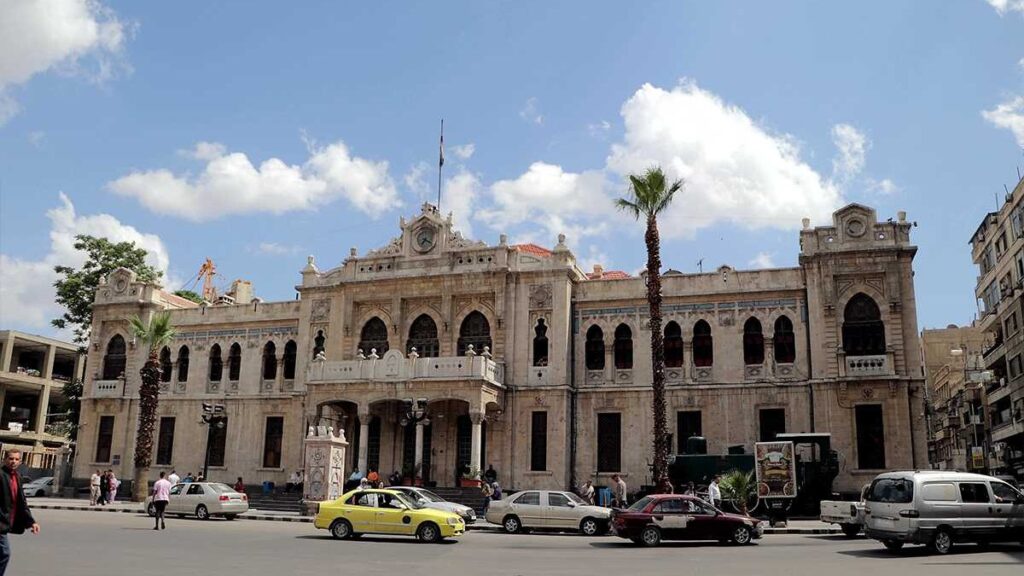
Before the souq, pause at the Hijaz Railway building near Marjeh Square. The station opened in the early 1900s to serve the line running toward the holy cities. Look at the tall arched windows, the carved stone, and the ironwork. Then imagine pilgrims with luggage and tickets in hand, waiting for a long train south. Peer down the tracks. Even if trains don’t run like they used to, the building still holds the feeling of departure and return. As a result, ten quiet minutes here put “journey” in your head—perfect before you step into the markets.
Walk to Al-Hamidiyyeh Souq — Your First Breath of the Old City

First impressions
From the museum and the station, make your way to Al-Hamidiyyeh Souq. When you step inside, the roof arches over you like a long tunnel of shade. It swallows the outside noise and replaces it with a softer, deeper sound: shopkeepers talking, metal tools tapping, the steady shuffle of feet, and, occasionally, a burst of laughter from a group of friends.
Look up
Importantly, look up at the roof. You will see small holes punched through the iron sheets. Light falls in dots and stripes, like daytime stars. People in Damascus tell stories about these holes—some say they date to an old conflict—but whatever their origin, they give the souq its special light.
A Roman route under an Ottoman roof
Remember the line under your feet. This covered market follows the old Roman street that once ran here. The souq you see now is about 300 years old, covered in the Ottoman period, and named after Sultan Abdulhamid II. Consequently, you are walking a Roman route beneath an Ottoman roof while living a modern day. That mix is Damascus.
What you’ll find
Across the aisles, you’ll see scarves, abayas, jackets, kids’ toys, copper dishes, soaps, prayer beads, travel bags, trinkets, and small surprises you didn’t know you wanted. Because the light slips through the roof in thin lines, the whole place looks like a stage set for everyday life.
Don’t miss: Bakdash
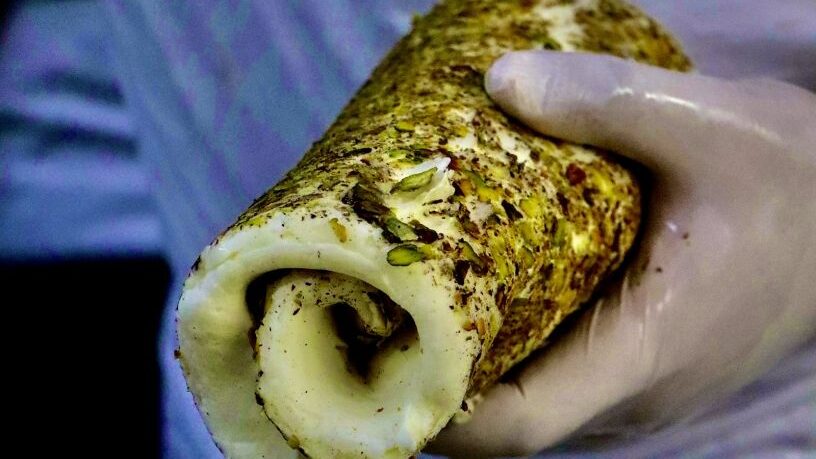
Above all, don’t miss Bakdash. The famous booza is elastic because it’s made with mastic and sahlab (orchid root). Workers pound and fold it with wooden mallets, then roll it in crushed pistachios. Order one and eat it standing in the doorway like everyone else. The bite is cold and chewy; meanwhile, the pistachios crack gently. It tastes simple, honest, and special—hence the fame.
Simple tip
If you plan to buy something later, notice prices now so you can compare. You don’t need to bargain hard; rather, use a gentle smile and a simple question.
At the End of the Souq: The Umayyad Mosque — 1,300 Years of Living Faith

How to enter
Keep walking to the end of Al-Hamidiyyeh. The market opens, the light gets strong again, and suddenly the Umayyad Mosque appears. Dress modestly; shoulders and knees should be covered. Women should bring a scarf or borrow a cloak at the entrance. Shoes come off before you step on the marble or into the prayer hall. If you’re unsure where to go, simply ask with a smile; someone will help.
Before it was a mosque
This site has been holy for a very long time. First there was an ancient Semitic temple; then a Roman temple of Jupiter; later, a Byzantine church of St. John the Baptist. In the early 700s it became the great mosque of the Umayyads. Therefore, you are standing where temple, church, and mosque meet in one story.
What to look for now
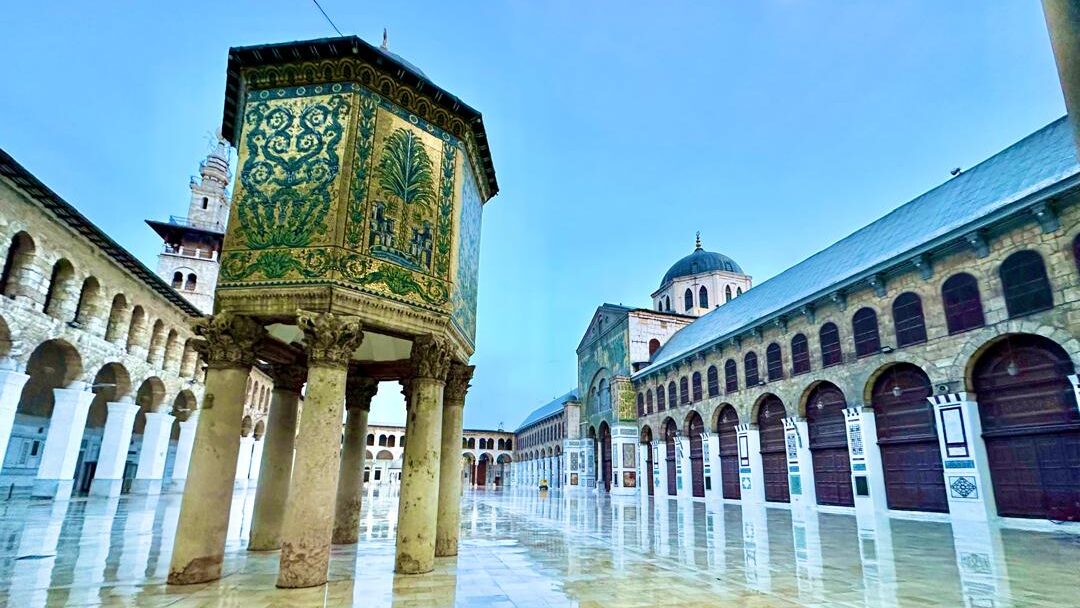
Mosaics. Along the arcades, gold-ground landscapes—trees, pavilions, imagined gardens—shine without human figures. The gold glows rather than shouts, making the courtyard feel like an eternal afternoon.
Three minarets. The Minaret of the Bride (north), the Minaret of Qaytbay (southwest), and the tall white Minaret of Jesus (southeast). People of Damascus believe that Jesus (Isa) will return at this minaret; later, you’ll spot it from the alleys and know exactly where you are.
Shrine of John the Baptist (Nabi Yahya). Inside the prayer hall, a small domed shrine is linked by tradition to the head of John the Baptist. Both Muslims and Christians honor him. Watch how visitors slow down; the air grows quiet around it.
Simple tip
Take a few photos, yes; then put your phone away and breathe. This is one of the calmest spots in the world.
A Short Walk to Al-Azm Palace — Old Damascus House, Open Like a Poem

From the mosque, continue to Al-Azm Palace (Qasr al-Azm). It is one of the largest Damascene palaces, built in the mid-1700s by Asʿad Pasha al-Azm, the powerful Ottoman governor. Later, it was restored and turned into the Museum of Arts and Popular Traditions. Accordingly, it shows you home life, not only grand rooms.
What to notice: every corner has a purpose. The palace shows two worlds in one home—the salāmlik (formal guest wing) and the ḥarāmlik (family wing). Courtyards hold fountains (bahra), citrus trees, and deep shade. Floors are laid in ablaq (light and dark stone). Iwans (deep arched sitting areas) catch the breeze. Moreover, wooden ceilings are carved and painted, and some rooms carry ‘Ajami decoration—raised gesso, thin metal leaf, and transparent color glazes that give a gentle, warm shine. Inside the displays, you’ll see furniture, kitchen tools, weaving, clothes, jewelry, musical instruments, and rooms arranged as families used them. Consequently, you learn how comfort was made with shade, air, and water, not machines.
Simple tip: sit for a minute by the fountain and let the sound settle in.
Into the Spice Souq — Scents You Can See
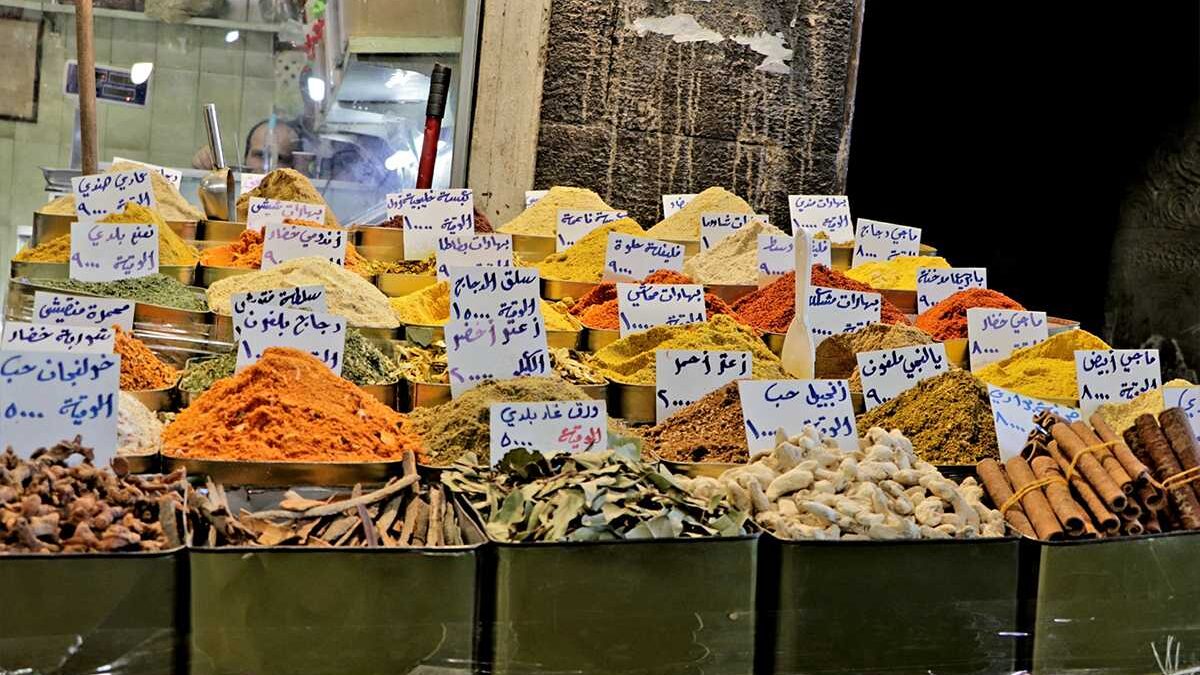
Leave Al-Azm Palace and walk into the spice souq (Souq al-Buzuriyyah). Here, the air is full of color you can almost taste. Pyramids of turmeric, cumin, cinnamon, cardamom, coriander, nigella (black seed), sumac, Aleppo pepper, anise, and dried rose petals glow under the lights. Jars of jam, bottles of rose water, and trays of dried fruits line the shelves. Meanwhile, shopkeepers scoop, weigh, and pour with practiced grace.
What to buy (and what it is):
Malban (grape scalp stuffed with walnuts)
Raha / Turkish delight (rose-scented cubes that melt softly)
Coated almonds (mlabbas) (crunchy sugar shells around nuts)
Dried fruits (apricots, figs, dates—taste first)
Spices (cumin for meat, coriander for warmth, sumac for tang, cardamom for coffee/desserts, cinnamon for stews/sweets, Aleppo pepper for gentle heat)
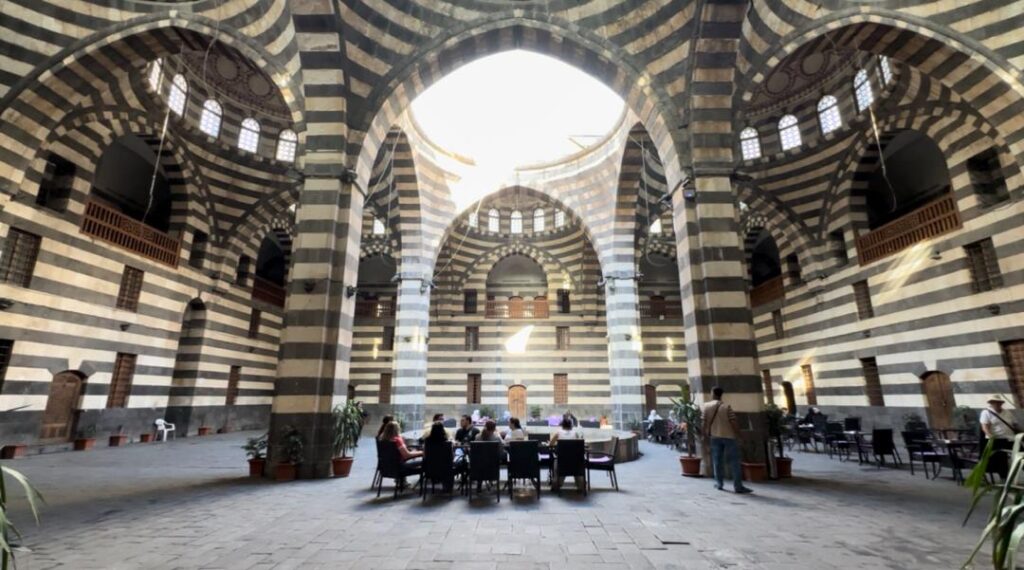
Caravanserai stop: step into Khan Asʿad Pasha. Look up at the nine domes with round skylights that pour daylight in circles on the floor. Traders once slept, ate, and stored goods here. Imagine camels kneeling, bundles stacked, and copper pots shining. Consequently, the building feels both strong and calm—it turns “trade and welcome” into stone.
Simple tip: ask for small sealed packets and the Arabic names; later, the scent will bring you back immediately.
Lunch at Ararat — Rest, Eat, Smile

By now, your feet want a pause. Head to Ararat Restaurant in Qaymariyya. It’s run with an Armenian family touch, and the food tastes like a warm table at home. Order lamb in a tray (siniyyeh—slow-baked lamb with vegetables) and freekeh (smoky green wheat) with chicken or lamb. Add fattoush or tabbouleh, warm bread, and pickles. Eat slowly; then talk about what you’ve seen so far. This is the moment that refills body, patience, and joy. Nevertheless, don’t overeat—you’ll want space for sweets or tea later.
Back Through Spices, Then the Jewelry Souq — Shining Metal, Quiet Lanes
After lunch, return through the spice souq and drift into the jewelry lanes. Light flashes on gold and silver. Small shops show rings, necklaces, and delicate chains. Even if you don’t buy, it’s good to see the city’s tiny work. If you want a simple souvenir, ask for a small silver pendant with a local motif. Keep it modest; the value is the memory.
Parallel to the Southern Wall of the Umayyad — Into Qabaqbiyeh Souq
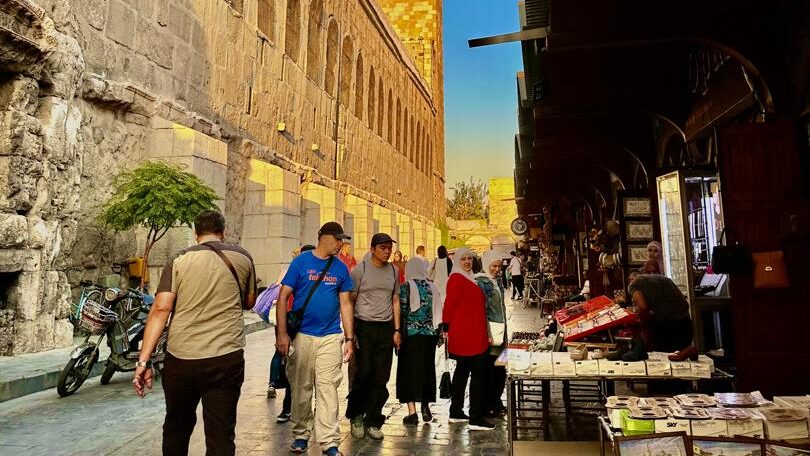
Turn right and walk on the lane that runs parallel to the southern side of the Umayyad Mosque, the mosque on your left. Soon, you reach Qabaqbiyeh Souq. Long ago it was famous for wooden qabaqib (bath clogs). Today, you’ll find easy souvenirs—magnets, old banknotes, keychains, and small wood pieces. Moreover, the mood is lively and friendly.
Look up: the Minaret of Jesus rises white and tall to your left. People of Damascus carry a long tradition that Jesus will return at this minaret. Whether you share the belief or not, it’s a hopeful landmark that watches the alleys.
The Jesus Minaret on Your Left — Slip into a Narrow Alley and Find Beit Jabri

Keep walking until the Jesus Minaret is clearly on your left. At that moment, turn right into a narrow, low alley; then turn left into an even narrower lane where no car can fit. After about 50 meters, you reach Beit Jabri (Jabri House)—a 300-year-old house that still belongs to the same family. Sit down and breathe out. The courtyard opens above you; plants lean over the edges; a fountain murmurs. In summer, try tūt shāmī (Damascene mulberry juice). If you like, enjoy a shisha in the open air.
On Mondays, Beit Jabri hosts a concert around 7:00 pm. If your visit falls on a Monday, book a ticket on the Evento app and enjoy music in the courtyard. If smoke bothers you, simply ask for a breezier corner.
A Workshop for ‘Ajami Art — Wood That Holds Color Like a Secret
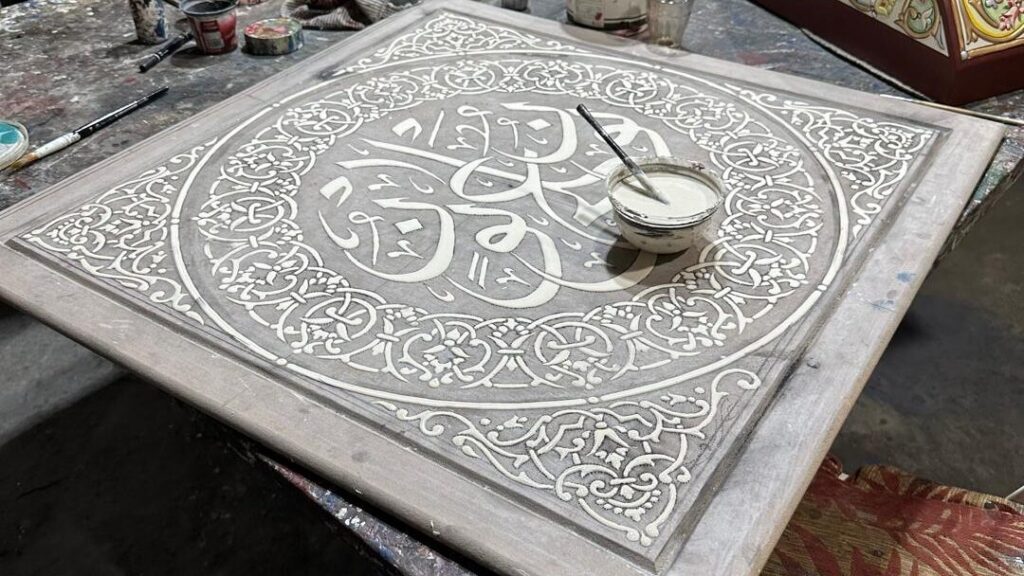
When you leave Beit Jabri, continue to a small ‘Ajami workshop. Watch the hands at work. The brush moves slowly; colors build in thin layers. Here’s the process: a wood panel is smoothed; gesso is piped in fine lines to make raised relief; metal leaf (silver/tin, sometimes gold) is laid; transparent colors are brushed over so the shine glows through; finally, a protective finish is added. As a result, the surface keeps a soft metallic warmth instead of a harsh glare. Motifs—tulips, carnations, vines, and pomegranates—repeat like a calm pattern. If you buy a piece, keep it dry, out of strong sun, and dust it gently.
First Left, Iron Gate on the Left — Anbar House, A Grand Jewish Home

Go back the way you came and take the first left. After a few meters, look left for a big iron gate. This is Anbar House (Beit/Maktab Anbar)—a large, historic Jewish mansion later used as a school and, today, often as a cultural venue. If it’s open, step into the courtyard; if not, a respectful look through the gate still shows its scale. Be polite with caretakers; a soft greeting and thanks go a long way.
Straight Street — The Oldest Street Still Doing Its Job
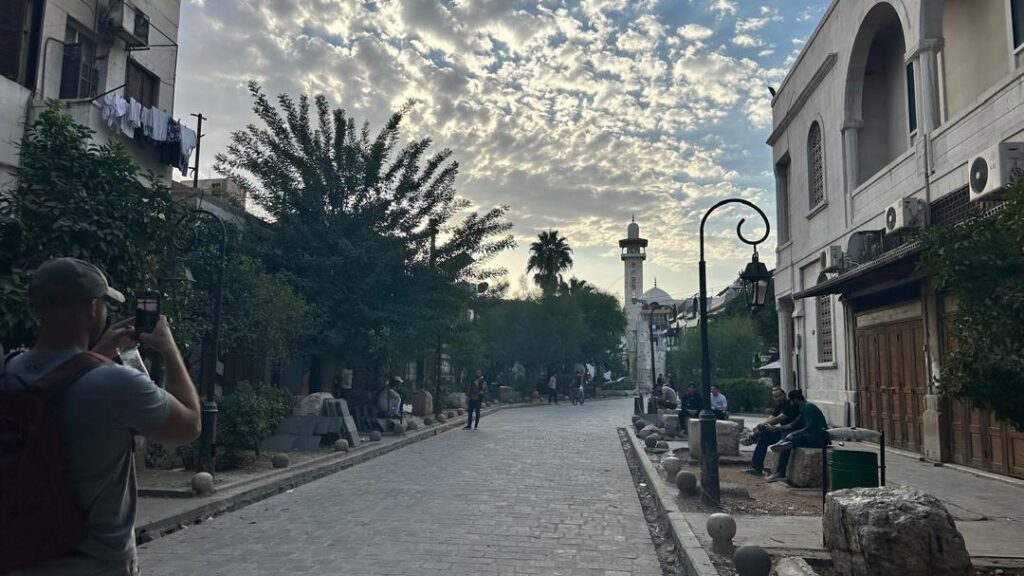
Continue walking until you reach Straight Street (Via Recta). It runs arrow-true through the Christian Quarter. Pause for a second and look both ways; the line is still clear after two millennia.
Along the way, notice the Victory Arch, the remaining piece of a once-grand triple arch. Nearby stands the Mariamite (Greek Orthodox) Cathedral—warm light, a glowing iconostasis, and a gentle quiet. On both sides, workshops keep the city alive: coppersmiths hammer bowls, carpenters plane boards, ceramic shelves bloom with blue and white, kilim looms hum, antiques gather softly, sword makers polish steel, mosaics flower like stone carpets, and silk brocade flows like water. If a craft catches your eye, stop; then ask a small question. Most artisans are happy to show how a pattern grows. For larger items such as mosaic tables or big brass trays, ask about shipping.
Bab Sharqi — The Eastern Gate
At the end of Straight Street, you reach Bab Sharqi, the Eastern Gate. It’s old and steady, a stone frame people still pass through daily. Walk under it slowly and, if you wish, touch the wall. Gates mark both arrivals and returns.
Turn Left for Ananias Church
After the gate, turn left into a narrow alley and follow it to Ananias Church, where Saint Paul is said to have been baptized. The church is small and low, almost hidden; that, in fact, is the charm. Step down, breathe the cool air, and let the past feel close. Please speak softly.
Evening: Qaymariyya Souq → Nofara Café (They Come Together)
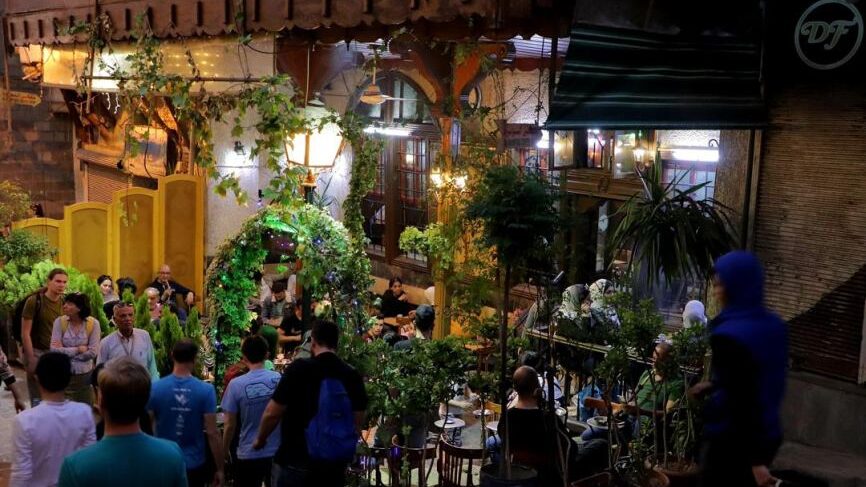
As sunset deepens, circle back toward the Umayyad area. You will pass through Qaymariyya anyway to reach Nofara Café for the storyteller, so think of the two as one flow. Qaymariyya at night is alive with street food—shawarma, falafel, manakish, juices, and sweets. Colorful shops throw warm light across the lane; people move quickly but not rudely; music drifts from open doors; a minaret draws a clean line against the sky. Eat small; taste a few things instead of one big dish.
At Nofara, order cumin tea or mint tea, grab a wooden chair, and wait for the ḥakawātī (storyteller) if he’s on. The voice rises and falls; the room leans in. This is not only a show for visitors. Rather, it’s a living habit of the city. Seats fill fast, so take one kindly and smile at your neighbor.
If you prefer a different mood, stay near the Christian Quarter at Qishla Café for a quiet unwind; choose a bar near Bab Sharqi (Abu George, Tiki, or De Marine) for a lively drink; or, alternatively, visit a traditional hammam (Zaher Beibars, Bakri, or Sheikh Raslan) for steam and a scrub. Bring a small bag, ask the attendant what the service includes, and then relax.
Dinner to Remember: Naranj — Home-Style Food, City-Style Care
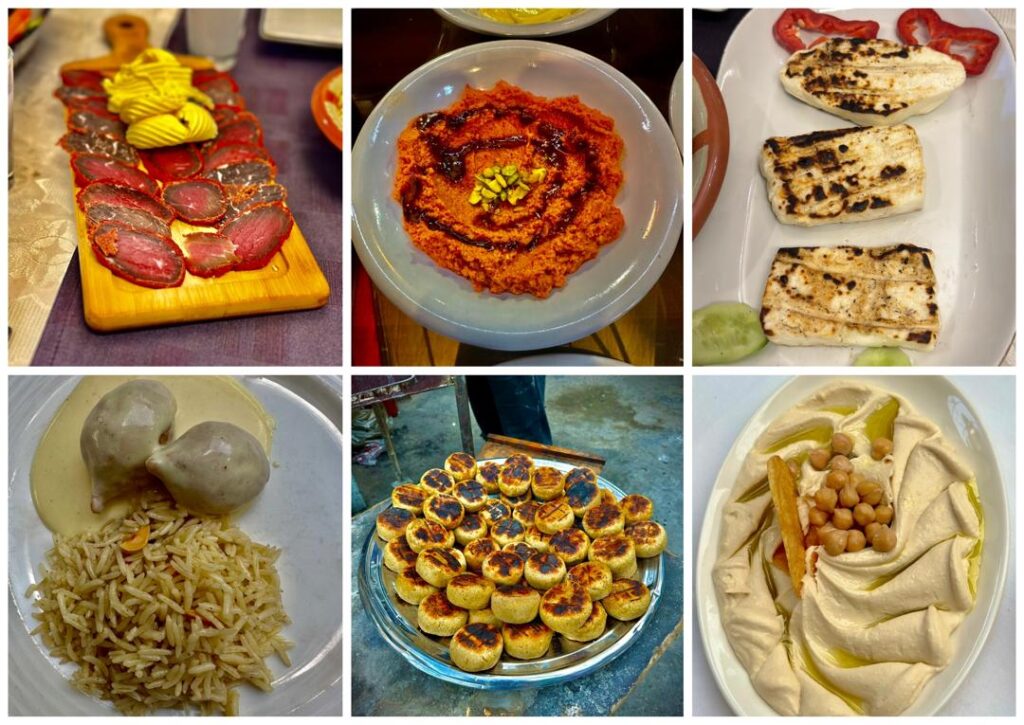
End the day at Naranj, a well-loved restaurant serving local, home-style dishes with care. Consider Harrak Esba’o (lentils and pasta with pomegranate molasses, fried onions, and crispy bread), Sayyadiyeh (fish with onion rice), Yabrak (vine leaves), and Maldum (eggplant, meat, tomatoes). Add salad and pickles. If you’re unsure, ask for one dish “your mother would make.” You’ll get something honest and good.
A Clear Walking Path (Turn by Turn)
- Start: National Museum (modern city, calm mind, Qasr al-Heer façade, open-air garden, Ugaritic tablets, Dura synagogue).
- Hijaz Railway building (ten-minute stop for the hall and tracks).
- Al-Hamidiyyeh Souq (look up at the roof holes; remember the Roman line; buy booza at Bakdash).
- Umayyad Mosque (mosaics; three minarets including the Jesus Minaret; shrine of John the Baptist; deep calm).
- Al-Azm Palace (one of the biggest; Azm family and Pasha; now the Museum of Arts & Popular Traditions).
- Spice Souq (malban, raha, coated almonds, rose water, spices) and Khan Asʿad Pasha (domes and light).
- Lunch at Ararat (Armenian family touch; lamb in a tray; freekeh).
- Back through spices → jewelry lanes (silver keepsakes).
- Walk parallel to the southern wall → Qabaqbiyeh Souq (magnets, old banknotes, souvenirs).
- When the Jesus Minaret is on your left, turn right, then left into a no-car lane, 50 m to Beit Jabri (mulberry/shisha; Monday concert at 7 pm—book on Evento).
- ‘Ajami workshop (raised gesso + metal leaf + transparent color).
- First left → Anbar House (big iron gate; grand Jewish mansion; step in if open).
- Straight Street (Victory Arch; Mariamite Church; watch copper, wood, ceramic, kilim, antiques, swords, mosaics, silk brocade).
- End: Bab Sharqi (Eastern Gate).
- Left to Ananias Church (small, low, cool).
- Evening flow: Qaymariyya → Nofara Café (storyteller + cumin tea) or Qishla / bars / hammam.
- Dinner: Naranj—close the day with Harrak Esba’o, Sayyadiyeh, Yabrak, or Maldum.
Practical Notes That Make the Day Easy
Shoes: wear comfortable shoes with good grip; old stone can be smooth.
Clothes: modest dress helps everywhere and is required at the mosque; carry a light scarf.
Cash: keep small notes for quick buys and tips.
Water: sip often; small shops are everywhere.
Photos: ask before photographing people or private spaces; “mumkin ṣūra?” is kind.
Pace: the Old City rewards slow walking—don’t try to “finish” it.
Buying: bargain gently with warmth; it’s a conversation.
Direction: use the Umayyad Mosque, Straight Street, and Bab Sharqi as landmarks.
Beit Jabri concert: Mondays around 7:00 pm—book on Evento and confirm with staff.
Why This Day Works
You began with the big picture at the museum, so your mind knew the story. Then you entered the living heart through Al-Hamidiyyeh and the Umayyad Mosque, so your feet felt the rhythm. After that, you stepped into homes—Al-Azm Palace and Beit Jabri—so your body knew the comfort of shade, water, and wood. Moreover, you watched craft grow under real hands; consequently, your eyes learned patience. Finally, you walked a straight line on Straight Street and passed through a gate that has seen more sunrises than anyone alive today. You end with voice, steam, food, or a rooftop, depending on your mood. Altogether, that balance—mind, feet, home, craft, line, gate, and evening—makes the day complete.
A Simple Ending: Sit, Listen, Remember
When the day is almost over and your plate at Naranj is empty, take a last small sip of tea. Breathe.
First, remember the museum’s quiet halls and the souq’s soft roar.
Then picture the bright marble of the Umayyad and the fountain in Al-Azm Palace.
Next, see the spices stacked in color and taste the mulberry drink in Beit Jabri. Think of the careful brush on ‘Ajami wood and the weight of Anbar’s iron gate.
Afterward, follow the steady line of Straight Street. Notice the hush inside Mariamite and the echo under Bab Sharqi, then the small steps down into Ananias.
Finally, hear the storyteller’s voice at Nofara, try the night food in Qaymariyya, smile at the laughter in Qishla, feel the steam of the hammam, and rest at the warm table in the end.
Not every city fits into one day; nevertheless, this one will sit in your chest for a long time.
And if someone asks later, “What is Damascus like?” simply smile and say, “Walk with me. I’ll show you.”
